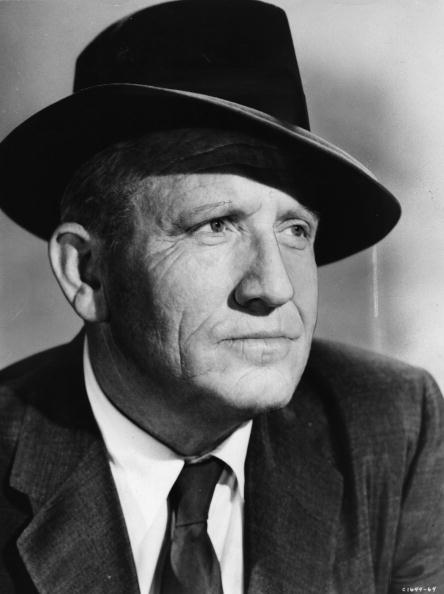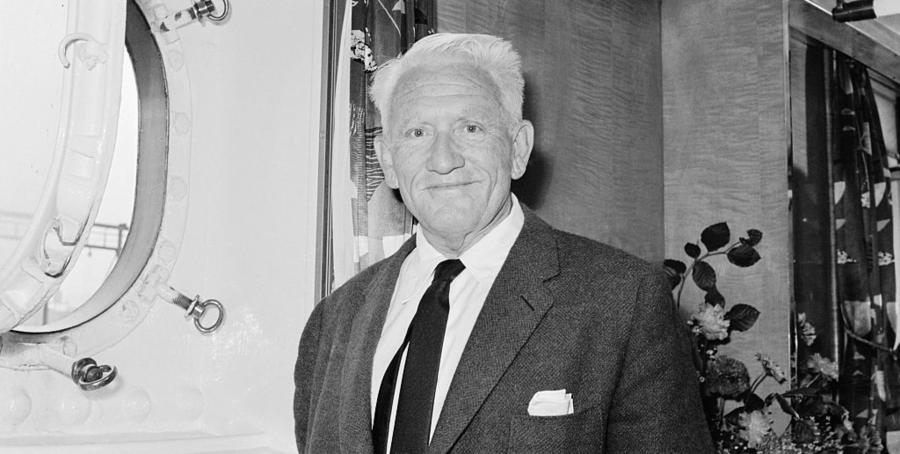What was Spencer Tracy's Net Worth?
Spencer Tracy was an American actor who had a net worth of $6 million at the time of his death in 1967. After adjusting for inflation, that's the same as around $50 million in today's dollars. Spencer Tracy was among the most famous movie stars of Hollywood's Golden Age. Nominated for nine Best Actor Academy Awards, he won two in consecutive years for "Captains Courageous" and "Boys Town." Tracy was also renowned for his partnership with actress Katharine Hepburn, starring alongside her in nine films over 25 years.
Early Life and Education
Spencer Tracy was born on April 5, 1900, in Milwaukee, Wisconsin, as the second son of Caroline and John. His brother was Carroll. An obstreperous child, Tracy was placed under the care of Dominican Order nuns when he was nine. As a teenager, he attended a number of Jesuit academies and developed his passion for the theatrical arts. Disinterested in his studies, he enlisted in the US Navy with his friend Pat O'Brien. Upon his return, Tracy graduated from high school and went on to enroll at Ripon College in Wisconsin. He was a very popular student there, appearing in many stage productions and competing on the debate team. In 1922, Tracy left Ripon after winning a scholarship to the American Academy of Dramatic Arts in New York City; he graduated from AADA in 1923.
Career Beginnings on Stage
After making his Broadway debut with a wordless role in the play "R.U.R.," Tracy landed a bigger but still relatively small part in the comedy "A Royal Fandango." He subsequently joined a struggling stock company in New Jersey and then moved to a company in Winnipeg that soon closed. Tracy finally found some success in 1926 in his third Broadway production, George M. Cohan's "Yellow." He went on to have hits with two more Cohan plays, "The Baby Cyclone" and "Whispering Friends." After those, Tracy appeared in "Conflict," "Dread," and "The Last Mile." For his lead role as a murderer on death row in the latter play, Tracy earned his highest acclaim yet.
Film Career in the 30s
Tracy transitioned to film in 1930, making his debut in John Ford's "Up the River." He subsequently appeared in such titles as "Quick Millions," "Disorderly Conduct," and "Me and My Gal," but remained mostly unknown to the public due to the films' lack of popularity. Tracy got better recognition for his role in the prison drama "20,000 Years in Sing Sing," but commercial success still eluded him. Things started to turn around in 1933 with his lauded performance in "The Power and the Glory." However, Tracy's heavy drinking took a toll on him, and his contract with Fox ended in 1935. He then moved to MGM, where his star rose considerably. After appearing in the studio's "The Murder Man," he found success with "Whipsaw," "Riffraff," and especially Fritz Lang's "Fury." Tracy then starred in the disaster film "San Francisco," earning him his first of nine Academy Award nominations for Best Actor. His reputation continued to grow with his role in the screwball comedy "Libeled Lady."
In 1937, Tracy had his biggest hit yet with the adventure film "Captains Courageous," based on the Rudyard Kipling novel. For his role as a Portuguese fisherman, he won the Academy Award for Best Actor. He next starred in "Big City," "Mannequin," and "Test Pilot." Tracy then won a second consecutive Academy Award for his role as Catholic priest Edward J. Flanagan in the 1938 biographical drama "Boys Town." After a bit of a break from the big screen, Tracy returned to Fox on loan to star in the 1939 adventure film "Stanley and Livingstone."

Hulton Archive/Getty Images
Film Career in the 40s and 50s
Tracy continued to seal his status as a top Hollywood star in the 40s. Starting the decade, he appeared in "I Take This Woman," "Northwest Passage," "Edison, the Man," and "Boom Town." He also reprised his Academy Award-winning role as Father Flanagan in "Men of Boys Town" and starred in his only horror film, "Dr. Jekyll and Mr. Hyde." In 1942, Tracy starred in his first of nine films with Katharine Hepburn, the romantic comedy "Woman of the Year." His other films with her during the decade were "Keeper of the Flame," "Without Love," "The Sea of Grass," "State of the Union," and "Adam's Rib." Tracy also had notable starring roles in "A Guy Named Joe," "The Seventh Cross," "Thirty Seconds Over Tokyo," and "Malaya," among others.
In 1950, Tracy earned his fourth Academy Award nomination for "Father of the Bride." He reprised his role in the sequel, "Father's Little Dividend," the following year. Tracy subsequently appeared in "The People Against O'Hara," "Pat and Mike," "Plymouth Adventure," "The Actress," and "Broken Lance." In 1955, he gave one of his most acclaimed performances in the neo-noir Western "Bad Day at Black Rock," winning Best Actor at the Cannes Film Festival and receiving his fifth Academy Award nomination. Tracy then left MGM and became an independent player. He went on to star in "The Mountain," "Desk Set," "The Last Hurrah," and "The Old Man and the Sea," earning another Academy Award nomination for the latter film.

Getty
Final Years on Film
Tracy began the final decade of his career starring in Stanley Kramer's 1960 adaptation of the play "Inherit the Wind"; he clinched his eighth Academy Award nomination for his performance as lawyer Henry Drummond. Tracy next starred in "The Devil at 4 O'Clock." His final three films were all directed by Stanley Kramer: "Judgment at Nuremberg," "It's a Mad, Mad, Mad, Mad World," and "Guess Who's Coming to Dinner." The lattermost film was his ninth and last film with Katharine Hepburn, and it was released posthumously six months after Tracy's passing; it became the highest-grossing film of his career. Hepburn won the Academy Award for Best Actress, while Tracy received a posthumous nomination.
Personal Life and Death
In 1923, Tracy married his first wife, actress Louise Treadwell. Together, they had a son named John who was deaf. When Tracy learned the news, he was wracked with guilt, believing that he was being punished by God for his sins. Tracy and Treadwell later had a daughter named Susie. In 1933, Tracy left the family and had a public affair with actress Loretta Young; he eventually reconciled with his wife, but remained separated from her. He went on to have several extramarital affairs, including with his co-stars Joan Crawford, Ingrid Bergman, and Myrna Loy. His greatest and most long-term relationship was with Katharine Hepburn, whom he was with until his passing.
Due to his alcoholism, chain-smoking, pill-popping, and obesity, Tracy was in significantly poor health by the time he reached his 60s. In 1963, he was hospitalized for pulmonary edema and severely high blood pressure, and a couple of years later was diagnosed with hypertensive heart disease. Over the next two years, he mostly stayed at home with Hepburn in Beverly Hills, spending his time painting, reading, and listening to music. In June of 1967, about 17 days after wrapping his final film role, Tracy passed away from a heart attack at the age of 67.
/2022/12/spencer-tracy.jpg)
/2022/11/katharine.jpg)
/2019/01/Henry-Fonda.jpg)
/2014/08/clark-gable.jpg)
/2017/08/james-cagney.png)
/2010/12/sydney.jpg)
/2014/03/GettyImages-468502344.jpg)
/2010/11/Perry-Farrell.jpg)
/2014/04/Eugenie-Bouchard.jpg)
/2020/06/tom-bergeron.jpg)
/2010/02/Emma-Watson.jpg)
/2020/10/Dave-Navarro.jpg)
/2020/01/pete-davidson.jpg)
/2010/07/GettyImages-75041205.jpg)
/2009/09/Daniel-Radcliffe.jpg)
/2016/08/stan2.jpg)
/2018/11/jp.jpg)
/2022/12/spencer-tracy.jpg)
/2010/12/sydney.jpg)
/2019/01/Henry-Fonda.jpg)
/2017/05/James-Stewart.jpg)
/2023/08/joan-fontaine.png)
/2025/04/Jason-Robards.jpg)
/2018/07/gary.png)
/2022/03/bette-davis-1.jpg)